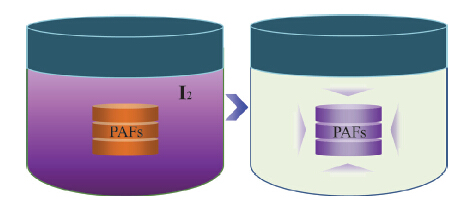| [1] Vienna, J. D. Int. J. Appl. Glass Sci. 2010, 1, 309.
[2] Kintisch, E. Science 2005, 310, 1406.
[3] Ewing, R. C.; von Hippel, F. N. Science 2009, 325, 151.
[4] Ojovan, M. I.; Lee, W. E. An Introduction to Nuclear Waste Immobilisation, Elsevier Science, Amsterdam, 2005.
[5] Jubin, R. T. Organic Iodine Removal from Simulated Dissolver Off-Gas Streams Using Silver Exchanged Mordenite, In Proceedings of the 16th DOE Nuclear Air Cleaning Conference, 1981, Paper No. CONF-8208322.
[6] Haefner, D. R.; Tranter, T. J. Methods of Gas Phase Capture of Iodine from Fuel Reprocessing Off-Gas: A Literature Survey, INL/EXT-07-12299, Idaho National Laboratory: Idaho Falls, ID, 2007.
[7] Hertzsch, T.; Budde, F.; Weber, E.; Hülliger, J. Angew. Chem., Int. Ed. 2002, 41, 2281.
[8] Chapman, K. W.; Chupas, P. J.; Nenoff, T. M. J. Am. Chem. Soc. 2010, 132, 8897.
[9] Wang, Z. M.; Zhang, B.; Fujiwara, H.; Kobayashi, H.; Kurmoo, M. Chem. Commun. 2004, 416.
[10] Choi, H. J.; Suh, M. P. J. Am. Chem. Soc. 2004, 126, 15844.
[11] Abrahams, B. F.; Moylan, M.; Orchard, S. D.; Robson, R. Angew. Chem., Int. Ed. 2003, 42, 1848.
[12] Dobrzańska, L.; Lioyd, G. O.; Raubenheimer, H. G.; Barbour, L. J. J. Am. Chem. Soc. 2006, 128, 698.
[13] Zeng, M. H.; Wang, Q. X.; Tan, Y. X.; Hu, S.; Zhao, H. X.; Long, L. S.; Kurmoo, M. J. Am. Chem. Soc. 2010, 132, 2561.
[14] Wang, Z. M.; Zhang, Y. J.; Liu, T.; Kurmoo, M.; Gao, S. Adv. Funct. Mater. 2007, 17, 1523.
[15] Sava, D. F.; Rodriguez, M. A.; Chapman, K. W.; Chupas, P. J.; Greathouse, J. A.; Crozier, P. S.; Nenoff, T. M. J. Am. Chem. Soc. 2011, 133, 12398.
[16] Sava, D. F.; Chapman, K. W.; Rodriguez, M. A.; Greathouse, J. A.; Crozier, P. S.; Zhao, H. Y.; Chupas, P. J.; Nenoff, T. M. Chem. Mater. 2013, 25, 2591.
[17] Kitagawa, H.; Ohtsu, H.; Kawano, M. Angew. Chem., Int. Ed. 2013, 52, 12395.
[18] Katsoulidis, A. P.; He, J. Q.; Kanatzidis, M. G. Chem. Mater. 2012, 24, 1937.
[19] Pei, C. Y.; Ben, T.; Xu, S. X.; Qiu, S. L. J. Mater. Chem. A 2014, 2, 7179.
[20] Hasell, T.; Schmidtmann, M.; Cooper, A. I. J. Am. Chem. Soc. 2011, 133, 14920.
[21] Sigen, A.; Zhang, Y. W.; Li, Z. P.; Xia, H.; Xue, M.; Liu, X. M.; Mu, Y. Chem. Commun. 2014, 50, 8495.
[22] Holst, J. R.; Stöckel, E.; Adams, D. J.; Cooper, A. I. Macromolecules 2010, 43, 8531.
[23] Stockel, E.; Wu, X. F.; Trewin, A.; Wood, C. D.; Clowes, R.; Campbell, N. L.; Jones, J. T. A.; Khimyak, Y. Z.; Adams, D. J.; Cooper, A. I. Chem. Commun. 2009, 212.
[24] Yuan, Y.; Yan, Z. J.; Ren, H.; Liu, Q. Y.; Zhu, G. S.; Sun, F. X. Acta Chim. Sinica 2012, 70, 1446. (元野, 闫卓君, 任浩, 刘青英, 朱广山, 孙福兴, 化学学报, 2012, 70, 1446.)
[25] Zhang, T. T.; Wang, H. T.; Ma, H. P.; Sun, F. X.; Cui, X. Q.; Zhu, G. S. Acta Chim. Sinica 2013, 71, 1598. (张婷婷, 王海涛, 马和平, 孙福兴, 崔小强, 朱广山, 化学学报, 2013, 71, 1598.)
[26] Wang, W.; Yan, Z. J.; Yuan, Y.; Sun, F. X.; Zhao, M.; Ren, H.; Zhu, G. S. Acta Chim. Sinica 2014, 72, 557. (王维, 闫卓君, 元野, 孙福星, 赵明, 任浩, 朱广山, 化学学报, 2014, 72, 557.)
[27] Song, W. C.; Xu, X. K.; Chen, Q.; Zhuang, Z. Z.; Bu, X. H. Polym. Chem. 2013, 4, 4690.
[28] Chang, Z.; Zhang, D. S.; Chen, Q.; Bu, X. H. Phys. Chem. Chem. Phys. 2013, 15, 5430.
[29] Yan, Z. J.; Yuan, Y.; Tian, Y. Y.; Zhang, D. M.; Zhu, G. S. Angew. Chem. Int. Ed. 2015, 54, 12733.
[30] Riley, B. J.; Chun, J.; Ryan, J. V.; Matyáš, J.; Li, X. S.; Matson, D. W.; Sundaram, S. K.; Strachan, D. M.; Vienna, J. D. RSC Adv. 2011, 1, 1704.
[31] Liu, Q. K.; Ma, J. P.; Dong, Y. B. Chem. Commun. 2011, 47, 7185.
[32] Sava, D. F.; Garino, T. J.; Nenoff, T. M. Ind. Eng. Chem. Res. 2012, 51, 614.
[33] Chen, Y. F.; Sun, H. X.; Yang, R. X.; Wang, T. T.; Pei, C. J.; Xiang, Z. T.; Zhu, Z. Q.; Liang, W. D.; Li, A.; Deng, W. Q. J. Mater. Chem. A 2015, 3, 87. |
